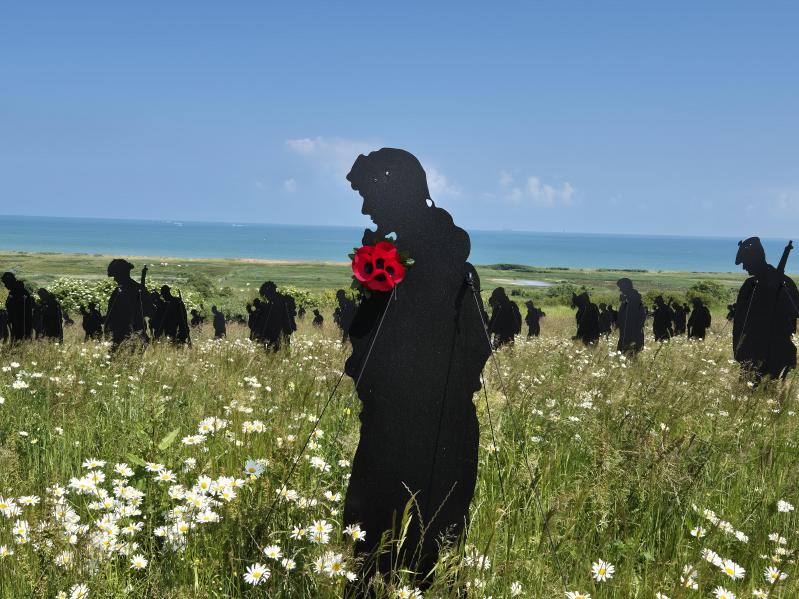President Biden and Dr. Jill Biden, the first lady, joined President Emmanuel Jean-Michel Frederic Macron and his wife last week in the 80th anniversary D-Day memorials to those who died rescuing France from Nazi occupation. D-Day was the beginning of the end of World War II.
The trip from Caen to Berlin is about 640 miles as a crow flies, a day's drive. It took the Allies, via the Netherlands, 11 months. Why so long? The answer is that while crossing the first bridge at Grave, over the Maas, or Meuse, River, went fine, the attempts at crossing the Waal River at Nijmegen and over the Dutch end of the Rhine at Arnhem were costly, and the plan failed abjectly.
I have a personal interest because many of my Dutch relatives died during the war. In 2011, my wife, Alice, and I joined French D-Day memorials in Laval and Normandy. A local veteran, Paul-Louis Cholet, organized a reunion for the families of two seven-man crews of Royal Air Force Halifax bombers that were shot down over Laval on June 10, 1944. A wonderfully thoughtful man and honorary battalion commander, Cholet died last year on Veterans Day.
My uncle, Flying Officer Willem J. van Stockum, piloted one of the two honored R.A.F. bombers on his sixth mission during the 10 days surrounding D-Day, out of Melbourne in Yorkshire. He was living with my parents and family in Washington, D.C., when the war broke out, teaching at the University of Maryland, seeking American citizenship. In 1944 he was still Dutch, so among the 13 R.A.F. tombstones of the two crews at the honorary gravesite in Laval, one is from the Dutch government.
In 2018, Alice and I visited the headquarters of the R.A.F. 10 Squadron in Melbourne, near York, England. The volunteer who helps families of 10 Squadron airmen, Susanne Pescott, joined us at a York restaurant, Betty's, showing us the bar once frequented by 10 Squadron pilots and other airmen. She also showed us the airfield, now an informal museum.
This year, Susanne attended the D-Day memorials in Normandy. She sent me a photo of the poppies she inserted in an R.A.F. aviator silhouette, for the lost airmen from 10 Squadron. It was among the 1,475 "living statues" representing the number of British airmen, sailors, and soldiers who died on the first day of the invasion. The fields of daisies where the lost men are represented are next to the British Normandy Memorial, close to the village of Ver-sur-Mer.
The Allied advance north through Paris and Belgium went fairly quickly. In early September 1944 the Allied 2nd Army was encamped below the Meuse-Escaut Canal, headed for Eindhoven, at the southern end of the Netherlands. Many — Germans and Dutch — thought the game was over. On "Mad Tuesday," Sept. 5, German soldiers, Dutch Nazis, and collaborators started fleeing for Germany, and some never came back.
But when, on Sept. 15, 1944, the Allies sent ahead their paratroopers to attack the bridges at Nijmegen and Arnhem, it was a slaughter, with lightly armed paratroopers facing thousands of unexpectedly ready Germans. The American and Polish paratroopers from the 82nd Airborne and the British paratroopers from the 1st Airborne were brave, but the best comparison is with the Charge of the Light Brigade.
As one American paratrooper said grimly: "We are going to Holland, and not to pick tulips." From that group, only three out of 20 survived. The movie "A Bridge Too Far" blames Field Marshal Bernard (Monty) Montgomery and Maj. Gen. Robert (Roy) Urquhart. General Eisenhower yielded to Montgomery's insistence on the plan, while not fully supporting it.
General Urquhart, in "Arnhem," his 1958 book on the disaster, blames British intelligence for not giving more credence to the Dutch Resistance, which understood the terrain and warned of the readiness of German troops and tanks.
Last month in England a new book called "The Traitor of Arnhem" by Robert Verkaik, a British journalist, appeared with a new theory. He claims that an art connoisseur, Anthony Blunt, one of the pro-Soviet Cambridge Five spy network, was the mysterious "Josephine" who leaked to Joseph Stalin's agents the Allies' top-secret plans to take Arnhem.
Verkaik theorizes that Stalin, through agents, forwarded the Arnhem attack plans to the Germans to enable them to block the Allies. Although the evidence is incomplete, the theory is plausible in light of Stalin's postwar focus on absorbing Eastern Europe into the postwar Soviet Empire. However much he loathed Hitler, Stalin did not want the Allies to get to Berlin before he did, especially since the Russians bore by far the greatest burden in the war against Hitler.
We cannot bring back to life the tens of thousands of people who died because of the failure at Arnhem — not just the Allied paratroopers who were killed, but the Dutch people who died of starvation during the ensuing winter.
What we can do is remember how long it took for the Allies to fight their way from Normandy north over three rivers to Arnhem. We can remember how much the Dutch suffered. We can remember how much better informed the Dutch Resistance was than the intelligence operations in London. And we can see how patterns in the way Stalin was looking at the situation in 1944 persist with his successor Vladimir Putin.
Most commentators I have read agree that the failure of the Allied operation at Arnhem resulted from intelligence failures that could have been ameliorated by paying more attention to the Dutch Resistance. The theory that Blunt's treachery and Stalin's imperial ambitions delayed an Allied victory by many months would explain it all. The Ukraine war is evidence that imperial ambitions are still alive in Moscow.
John Tepper Marlin has been a seasonal Springs resident since 1981. His latest book, "Under Nazi Noses," is an edited translation of a book about his cousin, the Dutch Resistance leader Walraven van Hall.

